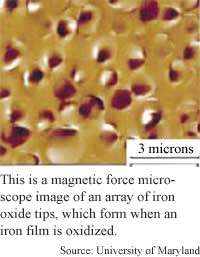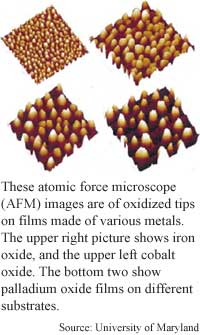
Bumps
could make better biochips
By
Kimberly Patch,
Technology Research NewsResearchers who make materials used in electronics -- like silicon wafers and thin metal coatings that are etched to form wires and other components -- are usually looking to keep the materials' surfaces smooth, because stray bumps, or defects are not conducive to conducting electrons without leading them astray.
A group of researchers from the University of Maryland, however, is taking the opposite tack by encouraging buckles, or tips to form in oxidizing metals. They have found that in at least four metals, they can control the oxidation process to produce a uniform sprinkling of tips on the surface of the materials.
Controlling this process is essentially a way of making materials self-assemble, said Ramamoorthy Ramesh, a professor of materials engineering and physics at the University of Maryland. This is one of several efforts to make a material do the work of forming structures at the microlevel, rather than physically carving out the tiny structures using relatively expensive methods like lithography.
The tips form when the surface of a metal absorbs oxygen, causing oxidation, or corrosion. Ordinary rust is a type of oxidation. When metals are oxidized they expand as much as 30 to 40 percent, said Ramesh "The oxidation typically is accompanied by huge volume change, so the crystal structure is different and there's a lot of surface stresses. And the material in some sense buckles up like a carpet, and it forms these blocky islands," said Ramesh.
The researchers produce uniform tips in oxidized palladium, copper, iron and cobalt by spreading very thin films of metal on silicon or glass, and heating them. "[If] I take a piece of glass like your window pane, coat [it] with about 500 angstroms of metal and oxidize it, I can get these tips at about 500 degrees," Ramesh said. An angstrom is about the width of an atom.
The key to a useful self-assembly process is making the tip formation predictable. The researchers have produced uniform sprinklings of tips ranging as tall as one micron and spaced two to seven microns apart.
Because these metals have good field emission properties, meaning they can predictably emit streams of electrons, these uniform tips could eventually be used to channel electrons, said Ramesh.
There are several potential applications along these lines, he said. The tips could be used to apply magnetic and electric fields to microfluidic systems in order to control fluid flowing through tiny channels. They could also be used to shoot electrons at the phosphors that light up in a field emission-type display screen. The iron oxide tips may also prove useful in future applications that require polarized electrons because 80 to 100 percent of the electrons emitted by iron oxide are spin polarized, said Ramesh.
Electrons exist in one of two states: spin up, or spin down. A stream of electrons is polarized when all the electrons are in the same state. Polarized electrons could eventually prove useful in electronics because the two states could represent the ones and zeros of binary communication.
The researchers are working to make the tips not only uniform, but, like crystals, periodic. A periodic structure has an exact pattern, making the exact location of each tip predictable.
The advantage of a periodic structure is that it scatters light evenly. "Anything that's periodic means it will start scattering [radiation] in a very coherent manner. That's why you can do x-ray diffraction or electron diffraction in crystals, because they have a periodic structure," Ramesh said. If the researchers can make the tips grow in a periodic manner, they may be able to use them for applications having to do with light, Ramesh said.
It's nice research because it shows development of uniformly sized oxide particles on on patterned surface, said Caroline Ross, associate professor of materials science at the Massachusetts Institute of Technology.
"In general, the self assembled processes are good for making structures... smaller than available with conventional lithography," said Ross. However, self assembled processes like these "suffer from the inability to precisely control the location of the structures. Their uses will be much greater if the nanostructure positions can be more precisely controlled," she added.
The researchers are working to understand the oxidation process better in order to more fully control the tips' growth process, said Ramesh. Ironically, they're going through literature from the '50s and '60s to augment their understanding of the process.
"This is a very well-known field," said Ramesh. But the research into the field has been largely aimed at preventing corrosion rather than encouraging it, he said. "People are worried because... one [tip] in a few hundred microns... can cause a short in their device. This is the other end of the spectrum where every few thousand angstroms you have a [tip] and there's a very uniform distribution."
The researchers' next steps are creating periodic structures, growing carbon nanotubes on top of the tips, and exploring the use of the tips as cathodes for use in batteries, Ramesh said.
Ramesh's research colleagues were Sanjeev S. Aggarwal, Satishchandra B. Ogale, Chandan S. Ganpule, Sanjay R. Shinde, Vlad A. Novikov, A. P. Monga, Mark R. Burr, Vincent Ballarotto and Ellen D. Williams. They published the research in the March 5, 2001 issue of Applied Physics Letters. The research was funded by the University of Maryland, Motorola and Telcordia.
Timeline: 5-10 years
Funding: Corporate, University
TRN Categories: Semiconductors and Materials
Story Type: News
Related Elements: Technical paper, "Oxide Nanostructures through Self-assembly," Applied Physics Letters, March 5, 2001.
Advertisements:
April 18, 2001
Page One
Defects boost disc capacity
Alternative quantum bits go natural
Light powers molecular piston
Bumps could make better biochips
Crystal changes shape in ultraviolet light


News:
Research News Roundup
Research Watch blog
Features:
View from the High Ground Q&A
How It Works
RSS Feeds:
News
Ad links:
Buy an ad link
| Advertisements:
|
 |
Ad links: Clear History
Buy an ad link
|
TRN
Newswire and Headline Feeds for Web sites
|
© Copyright Technology Research News, LLC 2000-2006. All rights reserved.